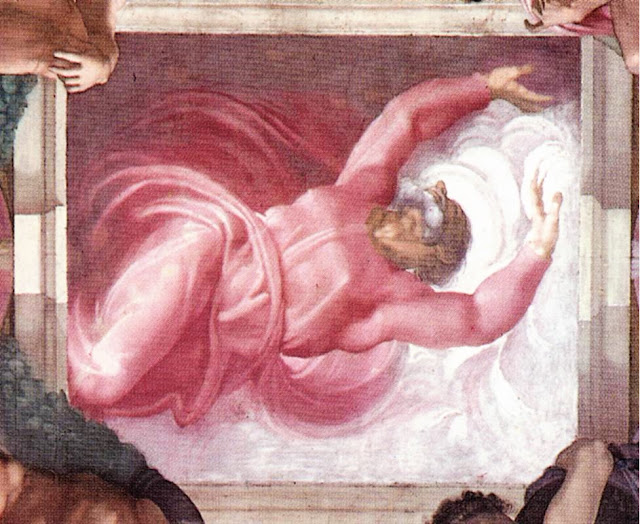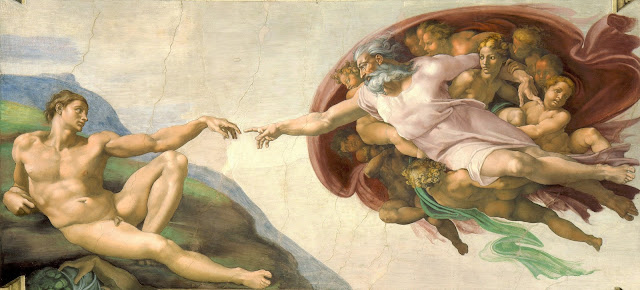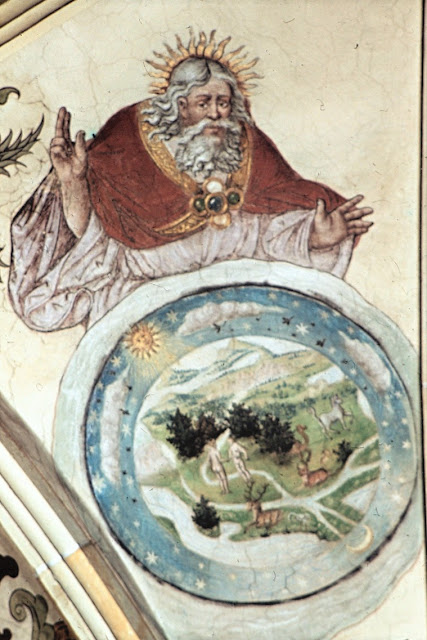 |
| Sano di Pietro, God Creating the Stars Cutting from a Manuscript Italian, 15th Century Paris, Musée Marmottan Monet Inv. M 6049 |
In Part One (here) we looked at the representation of the days of creation from Late Antiquity to just before 1400. Here we will look at the period from 1400 to the present.
This period includes one of the most famous of all works of art on this topic. That is the great series of paintings of subjects from Genesis done by Michelangelo on the ceiling of the Sistine Chapel at the beginning of the sixteenth century. Not surprisingly, this work permanently influenced the artists who followed him.
However, before Michelangelo painted his great masterpieces high above the heads of his audience many artists essayed their own interpretations about what those first days of the earth may have looked like. Chief among them were a group of masterful illuminators, who enriched the pages of Bibles and of prayer books with their ideas. But, first and foremost among the works they illustrated were a series of very popular paraphrases of the Bible, predominantly in French. These made the Biblical stories more accessible to an audience, literate in French, but not necessarily in Latin. They were among the best sellers of the medieval world. Indeed, the trade in highly illuminated prayer books and para-Biblical works was so strong that by the end of the thirteenth century most illumination was now done by professional scribes and illuminators, often organized in family groups, who offered their products for sale, just like today's publishers.
Late Middle Ages and Renaissance – 1400 to 1600
A Bible historiale by Guiard des Moulins, circa 1400. Although this manuscript is not attributed to any artist, the pictures are of a very fine quality.
,%20c.%201400_BNF_Francais%203,%20fol.%203v+earth.jpg) |
| The Creation of Light From a Bible historiale by Guiard des Moulins French (Paris), c. 1400 Paris, Bibliotheque nationale de France MS Francais 3, fol. 3v |
,%20c.%201400_BNF_Francais%203,%20fol.%203v.jpg) |
| The Creation of the Earth From a Bible historiale by Guiard des Moulins French (Paris), c. 1400 Paris, Bibliotheque nationale de France MS Francais 3, fol. 3v |
,%20c.%201400_BNF_Francais%203,%20fol.%204.jpg) |
| The Creation of the Plants From a Bible historiale by Guiard des Moulins French (Paris), c. 1400 Paris, Bibliotheque nationale de France MS Francais 3, fol. 4r |
,%20c.%201400_BNF_Francais%203,%20fol.%204v.jpg) |
| The Separation of the Waters From a Bible historiale by Guiard des Moulins French (Paris), c. 1400 Paris, Bibliotheque nationale de France MS Francais 3, fol. 4v |
,%20c.%201400_BNF_Francais%203,%20fol.%205.jpg) |
| The Separation of Water and Earth From a Bible historiale by Guiard des Moulins French (Paris), c. 1400 Paris, Bibliotheque nationale de France MS Francais 3, fol. 5r |
,%20c.%201400_BNF_Francais%203,%20fol.%205v.jpg) |
| The Creation of the Sun, Moon and Stars and of the Planats From a Bible historiale by Guiard des Moulins French (Paris), c. 1400 Paris, Bibliotheque nationale de France MS Francais 3, fol. 5v |
,%20c.%201400_BNF_Francais%203,%20fol.%206.jpg) |
| The Creation of the Fishes From a Bible historiale by Guiard des Moulins French (Paris), c. 1400 Paris, Bibliotheque nationale de France MS Francais 3, fol. 6r |
,%20ca.%201400_BNF_Francais%203,%20fol.%206v.jpg) |
| The Creation of Adam From a Bible historiale by Guiard des Moulins French (Paris), c. 1400 Paris, Bibliotheque nationale de France MS Francais 3, fol. 6v |
,%20ca.%201400_BNF_Francais%203,%20fol.%207r.jpg) |
| The Creation of the Birds and Animals From a Bible historiale by Guiard des Moulins French (Paris), c. 1400 Paris, Bibliotheque nationale de France MS Francais 3, fol. 7r |
,%20ca.%201400_BNF_Francais%203,%20fol.%207r2.jpg) |
| God Placing the Sleeping Adam in the Garden of Eden From a Bible historiale by Guiard des Moulins French (Paris), c. 1400 Paris, Bibliotheque nationale de France MS Francais 3, fol. 7r |
,%20ca.%201400_BNF_Francais%203,%20fol.%208r.jpg) |
| God Creating Eve From a Bible historiale by Guiard des Moulins French (Paris), c. 1400 Paris, Bibliotheque nationale de France MS Francais 3, fol. 8r |
,%20ca.%201400_BNF_Francais%209,%20fol.%204.jpg) |
| The Separation of Light and Darkness From a Bible historiale by Guiard des Moulins French (Paris), c. 1400 Paris, Bibliotheque nationale de France MS Francais 9, fol. 4r |
,%20ca.%201400_BNF_Francais%209,%20fol.%204v.jpg) |
| The Creation of the Firmament From a Bible historiale by Guiard des Moulins French (Paris), c. 1400 Paris, Bibliotheque nationale de France MS Francais 9, fol. 4v |
,%20ca.%201400_BNF_Francais%209,%20fol.%205.jpg) |
| The Separation of Earth and Water From a Bible historiale by Guiard des Moulins French (Paris), c. 1400 Paris, Bibliotheque nationale de France MS Francais 9, fol. 5r |
,%20ca.%201400_BNF_Francais%209,%20fol.%205v.jpg) |
| The Creation of the Sun and Moon From a Bible historiale by Guiard des Moulins French (Paris), c. 1400 Paris, Bibliotheque nationale de France MS Francais 9, fol. 5v |
,%20ca.%201400_BNF_Francais%209,%20fol.%206r.jpg) |
| The Creation of the Fish From a Bible historiale by Guiard des Moulins French (Paris), c. 1400 Paris, Bibliotheque nationale de France MS Francais 9, fol. 6r |
,%20ca.%201400_BNF_Francais%209,%20fol.%206v.jpg) |
| The Creation of the Birds, Animals and Man From a Bible historiale by Guiard des Moulins French (Paris), c. 1400 Paris, Bibliotheque nationale de France MS Francais 9, fol. 6v |
,%20ca.%201400_BNF_Francais%209,%20fol.%207v.jpg) |
| God Resting on the Seventh Day Amid the Birds and Animals From a Bible historiale by Guiard des Moulins French (Paris), c. 1400 Paris, Bibliotheque nationale de France MS Francais 9, fol. 7v |
,%20ca.%201400_BNF_Francais%209,%20fol.%208r.jpg) |
| God Placing Adam in Eden From a Bible historiale by Guiard des Moulins French (Paris), c. 1400 Paris, Bibliotheque nationale de France MS Francais 9, fol. 8r The way in which God is holding Adam, his new creation, is a reference to the image of the Trinity called, the Throne of Grace in which God the Father holds Jesus Christ, his Son and Second Person of the Holy Trinity, who is the New Adam. You can read about that image here and here. |
,%20ca.%201400_BNF_Francais%209,%20fol.%208v.jpg) |
| The Creation of Eve From a Bible historiale by Guiard des Moulins French (Paris), c. 1400 Paris, Bibliotheque nationale de France MS Francais 9, fol. 8v |
,%2015th%20Century_Paris,%20BNF_MS%20Latin%209471,%20fol.%201f.jpg) |
| Master of Rohan and Workshop, God Creating Heaven and Earth From the Grandes heures de Rohan French (Paris), First Half of the 15th Century Paris, Bibliotheque nationale de France MS Latin 9471, fol. 1r |
,%2015th%20Century_Paris,%20BNF_MS%20Latin%209471,%20fol.%201v.jpg) |
| Master of Rohan and Workshop, God Creating Night and Day From the Grandes heures de Rohan French (Paris), First Half of the 15th Century Paris, Bibliotheque nationale de France MS Latin 9471, fol. 1v |
Panel Painting, 1445, by Giovanni di Paolo
 |
| Giovanni di Paolo, Creation of the World and Expulsion from the Garden of Eden Italian, 1445 New York, Metropolitan Museum of Art, Robert Lehman Collection |
,%201447-1455_BNF_Latin%204915,%20fol.24r.jpg) |
| Master of Jouvenel des Ursins and Workshop, The Creation of Eve From the Mare historiarum by John of Cologne French (Anjou), c. 1447-1455 Paris, Bibliotheque nationale de France MS Latin 4915, fol. 24r |
,%201463_BNF_Francais%2050,%20fol.%2016v.jpg) |
| Master Francois and Workshop, The Creation of the World From the Speculum historiale by Vincent of Beauvais French (Paris), 1463 Paris, Bibliotheque nationale de France MS Francais 50, fol. 16v |
,%201463_BNF_Francais%2050,%20fol.%2019.jpg) |
| Master Francois and Workshop, The Creation of the Sun and Moon From the Speculum historiale by Vincent of Beauvais French (Paris), 1463 Paris, Bibliotheque nationale de France MS Francais 50, fol. 19r |
,%201463_BNF_Francais%2050,%20fol.%2020.jpg) |
Master Francois and Workshop, The Creation of the Birds and Fish From the Speculum historiale by Vincent of BeauvaisFrench (Paris), 1463 Paris, Bibliotheque nationale de France MS Francais 50, fol. 20r |
,%201463_BNF_Francais%2050,%20fol.%2021r.jpg) | |
|
 |
| Nicola da Novi, The Creation of the World Italian, c. 1506 Ripacandida, Church of San Donato |
 |
| Michelangelo Buonarroti, The Separation of Light and Darkness Italian, c. 1508-1512 Vatican City, Apostolic Palace, Sistine Chapel |
 |
| Michelangelo Buonarroti, The Separation of Earth and Water Italian, c. 1508-1512 Vatican City, Apostolic Palace, Sistine Chapel |
 |
| Michelangelo Buonarroti, The Creation of the Sun and Moon Italian, c. 1508-1512 Vatican City, Apostolic Palace, Sistine Chapel |
 |
| Michelangelo Buonarroti, The Creation of Adam Italian, c. 1508-1512 Vatican City, Apostolic Palace, Sistine Chapel |
 |
| Michelangelo Buonarroti, The Creation of Eve Italian, c. 1508-1512 Vatican City, Apostolic Palace, Sistine Chapel |
,%201542_BNF_Latin%208880,%20fol.%20182v-2%20(2).png) |
| Vincent Raymond, The Creation of the Sun and Moon From the Psalter of Paul III Italian (Rome), 1542 Paris, Bibliotheque nationale de France MS Latin 8880, fol. 182v |
 |
| Jobst Dorndorf, The Creation German, c. 1544-1546 Pirna, Church of Saint Mary Even in provincial Germany the dynamism of Michelangelo had an effect. |
 |
| Giulio Clovio, The Separation of Light and Darkness From the Farnese Hours Italian, 1546 New York, Pierpont Morgan Library MS M 69, fol. 59v |
 |
| Etienne Delaune, The Creation of the World From a Series of Illustrations of Genesis French, c. 1550-1575 London, Trustees of the British Museum |
 |
| Etienne Delaune, The Creation of Adam From a Series of Illustrations of Genesis French, c. 1550-1575 London, Trustees of the British Museum |
 |
| Etienne Delaune, The Creation of Eve From a Series of Illustrations of Genesis French, c. 1550-1575 Philadelphia, Museum of Art |
Once injected into the tradition, Michelangelo's dynamism became the tradition.
 |
| Tintoretto, The Creation of the Animals Italian, c. 1551-1552 Venice, Gallerie dell'Accademia |
.jpg) |
| Laurent Pecheux, The Creation of the World French, c. 1750-1760 Rome, Palazzo Barberini, Gallery V Ceiling |
Disproving a Common Misconception
- you can see farther out to sea from the side of a mountain than you can from the seashore (and, if high enough, you can see the curve of the earth in the distance)
- the shadow cast by the earth on the moon during a lunar eclipse is circular
- ships seen from a distance while at sea appear to disappear from the bottom up as they move away from you and the curve of the earth hides them from view.
- In cases where the unknown artist has been given a name associated with a manuscript or a place, I have chosen to use the term "his/her" in referring to their workshop. It is a fact that is still relatively unknown that many medieval artists, especially in the later medieval period, were women. Frequently, they were the wives and daughters of male artists, working in a family business. But they may also be widows, continuing to work at the family business after the death of its head. In addition, nuns or other religious women may also have worked as artists to support their communities. Evidence is not lacking for such women as Jeanne de Montbaston, who worked in the middle of the fourteenth century alongside her husband, Richard, in the family business in Paris, or the unnamed woman painter whose teeth, embedded with the costly pigment of lapis lazuli, were recently analyzed. See: Curry, Andrew, "Medieval Woman Artist Unmasked by Her Teeth", National Geographic, January 9, 2019, https://www.nationalgeographic.com/culture/article/female-medieval-master-artist-revealed-dental-calculus
- For a discussion of human knowledge on the shape of the earth see https://en.wikipedia.org/wiki/Spherical_Earth and https://www-istp.gsfc.nasa.gov/stargaze/Scolumb.htm. For information on the current connection between the Church and astronomical matters see the website of the Vatican Observatory at http://www.vaticanobservatory.va/content/specolavaticana/en.html
- For the geography of Dante’s imaginative voyage through Hell and Purgatory see: http://users.scc.spokane.edu/JRoth/Courses/World%20Masterpieces%20271/SOM%20Recordings%20W%202014/Dante/dantes%20geography%20document.pdf and http://www.lib.cam.ac.uk/exhibitions/Dante/geography.html
,%2015th%20Century_Paris,%20BNF_MS%20Latin%209471,%20fol.%202v.jpg)
,%2015th%20Century_Paris,%20BNF_MS%20Latin%209471,%20fol.%203v.jpg)
,%2015th%20Century_Paris,%20BNF_MS%20Latin%209471,%20fol.%204v.jpg)
,%2015th%20Century_Paris,%20BNF_MS%20Latin%209471,%20fol.%205v.jpg)
,%2015th%20Century_Paris,%20BNF_MS%20Latin%209471,%20fol.%206v.jpg)
,%2015th%20Century_Paris,%20BNF_MS%20Latin%209471,%20fol.%207v.jpg)
,%201447-1455_BNF_Latin%204915,%20fol.21v.jpg)
,%201447-1455_BNF_Latin%204915,%20fol.22.jpg)
,%201447-1455_BNF_Latin%204915,%20fol.23r.jpg)
,%201447-1455_BNF_Latin%204915,%20fol.23v.jpg)
,%201463_BNF_Francais%2050,%20fol.%2017v.jpg)
,%201463_BNF_Francais%2050,%20fol.%2018.jpg)
,%201463_BNF_Francais%2050,%20fol.%2020v.jpg)

.gif)
No comments:
Post a Comment